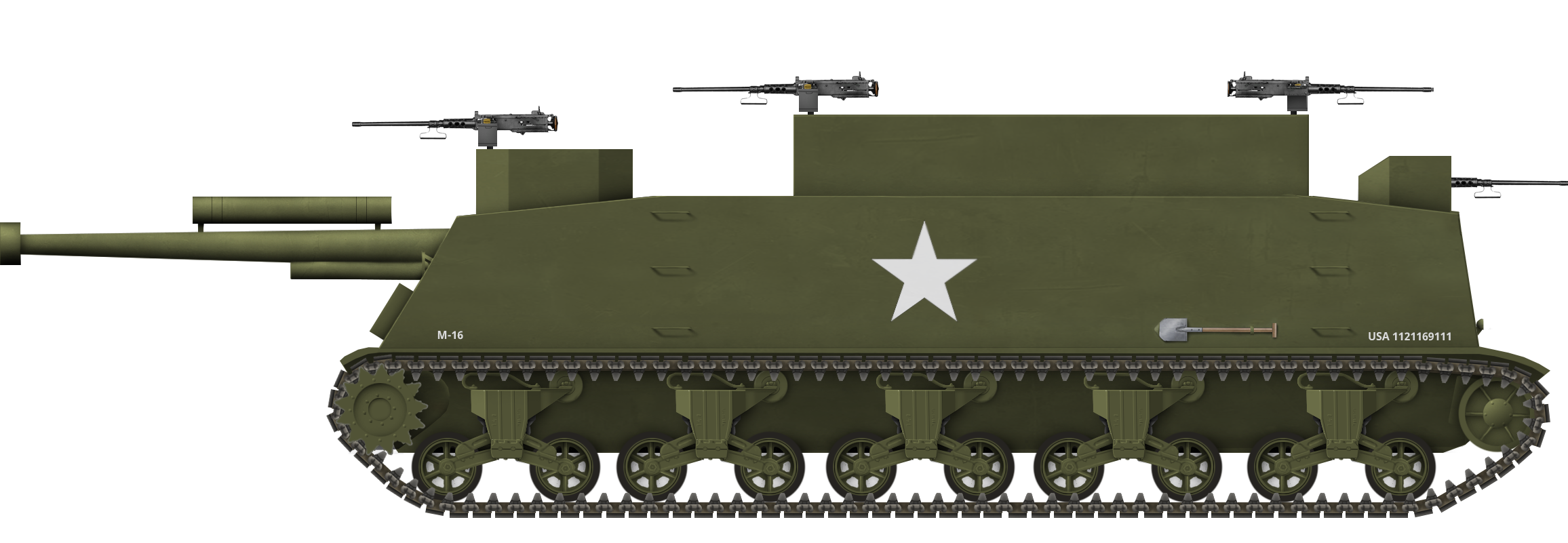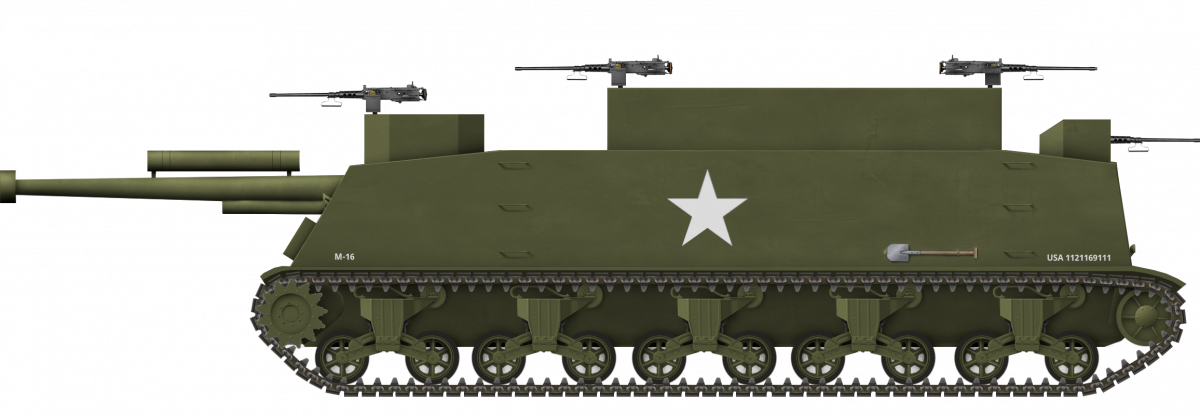 United States of America (1962)
United States of America (1962)
Self-Propelled Gun – Proposal Only
In 1962, an up and coming tank designer drew up plans for a new type of fighting vehicle. Ostensibly a self-propelled gun, the design was closer to a hybrid between an assault gun and a Vietnam gun truck, with the forward half of the vehicle dedicated to a 105 mm howitzer, and the rearward half to an elevated platform with multiple mounted machine guns. This was the brainchild of Mark Kubiak, a boy living in Spokane, Washington. He called the vehicle “M-16”, clearly confident enough in its adoption by the Army that it would not require a prototype “T” number, yet distinct from the Army’s own nomenclature, which did not use dashes.


From the Mind of Babes
While the chassis was unspecified, it clearly took inspiration from the M4 Sherman. The running gear consisted of 5 Vertical Volute Spring Suspension (VVSS) units per side, each having 2 roadwheels and built-in return rollers. The drive sprocket is assumed to be at the front, as the idler at the rear extends somewhat beyond the rear of the tank, again much like the Sherman family of vehicles.
Mounted directly over the drive sprockets was an unspecified 105mm howitzer, which, due to its design and the time period, can be reasonably inferred to be an M101, a World War II artillery piece formerly known as the M2A1, which continued to see service throughout the Vietnam War. The placement of the main armament so far forward would certainly have caused suspension issues, and the transmission being mounted directly underneath would have greatly reduced the gun’s ability to elevate. Beside the howitzer was a raised, circular position resembling the “pulpit” of the M7 Priest, having a pintle-mounted M2 Browning .50 caliber machine gun. It is not specified whether this machine gun position was to the left or right of the cannon, but given that the driver would necessarily be on the side opposite the machine gunner, and that an ammunition rack was placed on the left, the machine gun position was most likely to the left of the howitzer and the driver seated to the right. Rearward of the machine gun position was a spacious open-topped fighting compartment for the crew servicing the 105mm howitzer, likely consisting of a gunner and at least two cannoneers. Ammunition racks were placed along either side wall, and in the front left corner of the fighting compartment.
Rearward of the main fighting compartment was a raised passenger/secondary fighting compartment, built on top of and around the engine. A pintle-mounted M2 Browning was placed on the front wall of this compartment and another on the rear wall, both on the centerline of the vehicle. The raised position of the secondary fighting compartment would allow the forward machine gunner to fire over the heads of the howitzer crew. .50 caliber ammunition was stowed along the walls on both sides of the secondary fighting compartment.
At the very rear of the vehicle was a small, open-topped one-man turret mounting another M2 Browning. It was offset slightly to port (left) from the centerline of the vehicle and was provided with its own ammunition rack, in the left rear corner of the hull. Presumably, the operator of this machine gun could only enter his position via the turret, an unpleasant and psychologically-daunting place to be, next to the engine and separated from the rest of the crew.
Armor is unspecified, but was likely only enough to withstand small arms fire. For a vehicle of this size, even a small increase in armor would result in a large increase in weight, and heavy armor would be wasted on an open-topped vehicle to which the greatest threat would be artillery and mortar fire.
The only measurement given as to the size of the vehicle was that it should be “about 15 yards (13.7 m) long”. Even if this is taken to include the overhang of the barrel, at 45 feet long the M-16 would be truly enormous. For comparison, the length of the M4 Sherman was about 20 feet (6.1 m), and the length of the K-Wagen, the largest tank ever built in terms of dimensions, was just under 43 feet (13 m). Scaling the design off of the VVSS suspension units would result in a length of about 40 feet (12.2 m), near enough to the inventor’s stated figure that the difference may just be an error in the drawing.
The ammunition load of the vehicle was specified by weight, 100 pounds (45.4 kg) of .50 caliber ammunition and 500 pounds (226.8 kg) of 105 mm shells. Mr. Kubiak seems to have greatly underestimated the weight of ammunition, as 100 pounds would only account for three 100-round .50 caliber belts, while the vehicle has four .50 caliber guns and numerous ammo racks. A more reasonable number would be sixteen 100-round canisters, weighing about 560 pounds (254 kg). The standard HE shell used by both the 105mm M101 and M103 cannons (the latter being the gun mounted in the T195, mentioned later) was the Cartridge, 105 mm HE, M1, which weighed 40 pounds (18 kg). This means that the vehicle, as described, would only carry 12.5 rounds. A complement of 86 rounds of 105 mm ammunition, the same number carried by the vehicle to which the M-16 would be compared by the Army, would weigh 3,440 pounds (1,560 kg).
Directly to the Top
The blueprints were delivered in a small unassuming envelope with a 4 cent stamp, canceled at a Spokane, Washington post office at 4:10 PM on November 15, 1962. The letter was addressed to none other than President John F. Kennedy, with the address written simply as “White House, Washington D.C.”. The handwriting on the envelope did not match Mr. Kubiak’s, probably being written by one of his parents. Along with the original blueprints for the vehicle, a letter of explanation was enclosed. It read:
“Mr. President, The M-16 contains 105-MM Howitzer and 4 50-caliber machine guns its length is al should be about 15 yards long. It should carry 500 pounds of howitzer shells and 50 100 pounds of 50-caliber machine gun bullets. – Mark Kubiak, 112 W 33rd, Spokane 42 Wash.
PS. it can shoot down planes and destroy tanks and other vehicles.”
Despite the matter being on the order of importance befitting the Commander in Chief, regulations dictated that the message was passed through channels via the Department of the Army, Office of the Chief of Staff on 26 November, to the Office of the Chief of Research and Development, and thereunder to the Combat Materiel Division, which evaluated the proposal. The evaluation process itself was unfortunately not recorded, but it seems that the M-16 was written off summarily. The Memorandum for the Record, which was written up by Major Benjamin B. Williams and dated 18 December 1962, records the pertinent facts of the case, and summarizes the final action taken was to send a letter to Mr. Kubiak informing him of the similarities between his design and the existing T195E1, which would later be standardized as the M108 self-propelled howitzer. Additionally, the Memorandum noted that Mr. Kubiak’s age was estimated to be 8 to 11 years old based on the letter and sketches he submitted.

The letter of response was prepared on 18 December by Major Williams and signed by Colonel Brooks O. Norman, Chief of the Combat Materiel Division, and was dispatched the next day. It informed Mr. Kubiak that his letter to the President was forwarded to this office, and pointed out that his ideas about self-propelled artillery doctrine were in line with the Army’s, but that the Army already had a design very similar to the M-16 which was in the final stages of development and would be issued to units soon, the T195E1, of which a photograph was forwarded. Colonel Norman went on to contrast the two designs, pointing out that the T195E1 was only half the length of the M-16, and that it carried much more 105mm ammunition. The T195E1 carried about the same amount of .50 caliber ammunition as the M-16, but only had one machine gun instead of four, clearly making it inferior in the anti-aircraft role. Colonel Norman also mentioned that the T195E1 carried a bazooka for anti-tank purposes, but this was hardly a unique ability; the M-16’s spacious passenger compartment would have ample room for additional ammunition and multiple shoulder-launched weapons. Perhaps the Colonel was alluding to this for possible inclusion on an anticipated revised design of the M-16, as the Office had notably declined to reject Mr. Kubiak’s proposal. Perhaps there was potential in the idea, if only the inventor would clarify the distinction in role between the M-16 and T195.
Unfortunately, Mr. Kubiak did not seem to recognize the invitation to further development, as no response was recorded from him. The M-16 was but one design in a vast sea of weapon proposals submitted by civilians, most being totally impractical, physically impossible, or just useless. While flawed, the M-16 was nowhere near the worst of such proposals. Its design shows greater understanding of tank design than that of many adults who also wrote in to the Army to pitch their tank ideas.

Sources
OCRD Project Control Files of the Combat Arms Branch, Correspondence File “252/7 105mm Howitzer FY 62”


7 replies on “Mark Kubiak’s M-16”
Reminds me of something I would draw when still in the fourth and fifth grade for fun.
If only you had thought to send your drawing in to a federal agency, then they would be forever recorded as a part of history!
Better than what I designed. I went for the multi-turreted approach.
When I was Mr. KubiaK’s age (1970/72), I had just started with plastic modelling. I think his knowledge about tanks has similar roots. I remember, that I took many structures on my kits as a given without knowing, what they were for in the real thing. The working of the recoil mechanism of an artillery gun f.e. was something I undestood decades later. I think, that Mr Kubiak tried to draw a M2A1 (M101) 105 mm howitzer. The cylindrical structure above the barrel would be part of the recoil mechanism. If Mr Kubiak didn’t know its function, it’s no wonder he painted it somewhere he thought it was right.
Since Pavel Alexe corrected the rather crude drawing of the bogeys, perhaps the gun should be drawn closer to the M101 too.
Is the full response letter available somewhere?
The next premium TD to be introduced into World of Tanks.
In my opinion Kubiak’s proposal is fusion between M7 Priest and actual M16 namely M16 MGMC, latter featured 4 .50 machine guns and “can shoot down planes”. M16 MGMC has quad mount, rather than single mount for each machine gun, which is difference, which might be explained by Kubiak having only short description of M16 MGMC, but not photo nor model. Considering time I find it plausible that one of Kubiak’s relatives have first-hand experience with M16 MGMC, as these were used during Korean War.